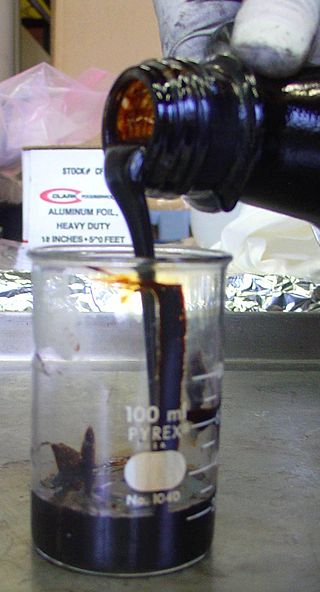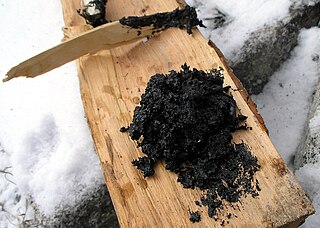Related Research Articles
Coal tar is a thick dark liquid which is a by-product of the production of coke and coal gas from coal. It is a type of creosote. It has both medical and industrial uses. Medicinally it is a topical medication applied to skin to treat psoriasis and seborrheic dermatitis (dandruff). It may be used in combination with ultraviolet light therapy. Industrially it is a railroad tie preservative and used in the surfacing of roads. Coal tar was listed as a known human carcinogen in the first Report on Carcinogens from the U.S. Federal Government, issued in 1980.

Creosote is a category of carbonaceous chemicals formed by the distillation of various tars and pyrolysis of plant-derived material, such as wood, or fossil fuel. They are typically used as preservatives or antiseptics.
In computing, tar is a computer software utility for collecting many files into one archive file, often referred to as a tarball, for distribution or backup purposes. The name is derived from "tape archive", as it was originally developed to write data to sequential I/O devices with no file system of their own. The archive data sets created by tar contain various file system parameters, such as name, timestamps, ownership, file-access permissions, and directory organization. POSIX abandoned tar in favor of pax, yet tar sees continued widespread use.

Tarring and feathering is a form of public torture and punishment used to enforce unofficial justice or revenge. It was used in feudal Europe and its colonies in the early modern period, as well as the early American frontier, mostly as a type of mob vengeance.

Teichoic acids are bacterial copolymers of glycerol phosphate or ribitol phosphate and carbohydrates linked via phosphodiester bonds.

Pine tar is a form of wood tar produced by the high temperature carbonization of pine wood in anoxic conditions. The wood is rapidly decomposed by applying heat and pressure in a closed container; the primary resulting products are charcoal and pine tar.

The Tar-Baby is the second of the Uncle Remus stories published in 1881; it is about a doll made of tar and turpentine used by the villainous Br'er Fox to entrap Br'er Rabbit. The more that Br'er Rabbit fights the Tar-Baby, the more entangled he becomes.

Tar is a dark brown or black viscous liquid of hydrocarbons and free carbon, obtained from a wide variety of organic materials through destructive distillation. Tar can be produced from coal, wood, petroleum, or peat.

Two Tars is a silent short subject directed by James Parrott starring comedy duo Laurel and Hardy. It was released by Metro-Goldwyn-Mayer on November 3, 1928

The North Carolina Tar Heels football team represents the University of North Carolina at Chapel Hill in the sport of American football or Gridiron Football. The Tar Heels play in the Football Bowl Subdivision (FBS) of the National Collegiate Athletic Association (NCAA) and are members of the Atlantic Coast Conference (ACC).
"Tar Baby" was the name given by the United States State Department to Richard Nixon's policy during the late 1960s and 1970s of strengthening contacts with the white-minority governments in southern Africa — Portugal, Rhodesia and apartheid-era South Africa. The allusion was to the Uncle Remus story in which Brer Fox tries to capture Brer Rabbit by making a tar baby. Brer Rabbit strikes the tar "baby" with his hands, feet, and head and eventually becomes completely adhered to it. The policy option, described as a partial relaxation of economic action against Rhodesia, South Africa and Portugal, and derived from NSSM: 39, was based on the presumption that apartheid and colonial rule were an unpleasant but undeniable reality and that Washington should accommodate itself pragmatically to the status quo. According to Nixon, if the United States was to be an influence for enlightened change it must do so by offering the "carrot" and eschewing the "stick". This policy would have to be pursued ad infinitum to get it to work.
In enzymology, a threonine-tRNA ligase is an enzyme that catalyzes the chemical reaction

Birch (bark) tar or birch pitch is a substance derived from the dry distillation of the bark of the birch tree.

Nimbus Roman is a serif typeface created by URW Studio in 1982.

Nimbus Mono is a monospaced typeface created by URW Studio in 1984, and eventually released under the GPL and AFPL in 1996 and LPPL in 2009. In 2017, the font, alongside other Core 35 fonts, has been additionally licensed under the terms of OFL. It features Normal, Bold, Italic, and Bold Italic weights, and is one of several freely licensed fonts offered by URW++. Although not exactly the same, Nimbus Mono has metrics and glyphs that are very similar to Courier and Courier New.
The 1953–54 North Carolina Tar Heels men's basketball team represented the University of North Carolina at Chapel Hill. The head coach was Frank McGuire. The team played its home games at Woollen Gymnasium in Chapel Hill, North Carolina, and was a member of the Atlantic Coast Conference.
Jack Tar Hotels was an international hotel chain based in the United States.

La Brea Woman was a human whose remains were found in the La Brea Tar Pits in Los Angeles, California. The remains, first discovered in the pits in 1914, are the partial skeleton of a woman. At around 18–25 years of age at death, she has been dated at 10,220–10,250 years BP. These are the only human remains to have ever been discovered at the La Brea Tar Pits.
The Pine Tar Incident was a controversial incident in 1983 during an American League baseball game played between the Kansas City Royals and New York Yankees at Yankee Stadium in New York City on Sunday, July 24, 1983.
The 1953 North Carolina Tar Heels football team represented the University of North Carolina at Chapel Hill during the 1953 college football season. The Tar Heels were led by first-year head coach George T. Barclay, and played their home games at Kenan Memorial Stadium. The team competed as a member of the Atlantic Coast Conference, in the conference's inaugural year, finishing tied for third.
References
- ↑ Rapini, Ronald P.; Bolognia, Jean L.; Jorizzo, Joseph L. (2007). Dermatology: 2-Volume Set. St. Louis: Mosby. ISBN 1-4160-2999-0.